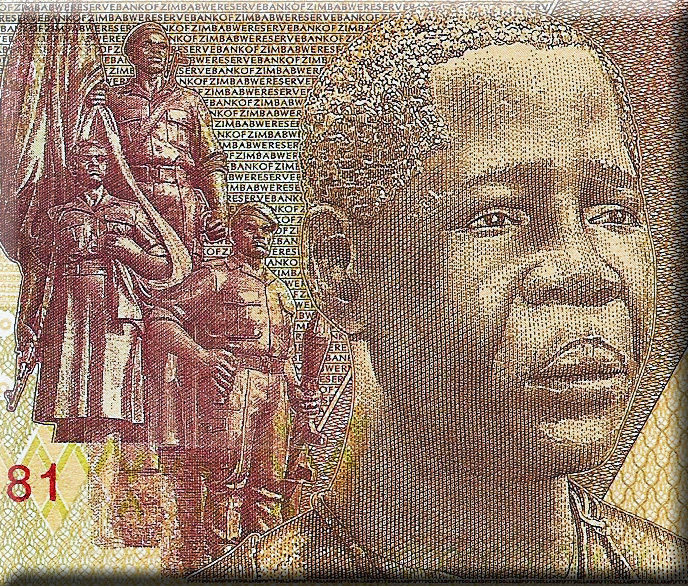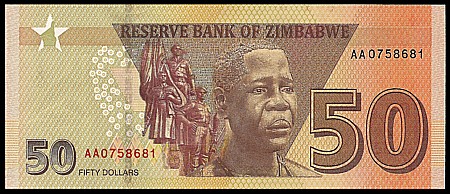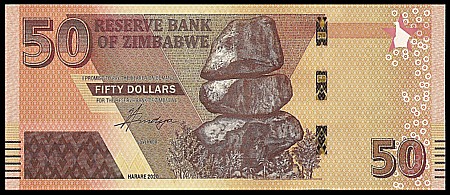ZIMBABWE
Mbuya (Charwe Nyakasikana) Nehanda

Zimbabwe’s newest banknote was greeted with skepticism by many, despite governmental assurances that this new $50 banknote, currently the highest denomination issued by the Reserve Bank of Zimbabwe, would not generate inflation. At the time of its release on 06 July 2021, the $50ZWD note was worth $0.60USD, and it quickly fell to $0.13USD where it still was as of 26 July 2021. Clearly the public still distrusts their government and still uses foreign currencies, including the US Dollar, the South African Rand and the Botswana Pula.
The 2021 $50 banknote features the balancing rocks at Chiremba, still larger than life, while the back of the banknote prominently features the bust of Mbuya (Charwe Nyakasikana) Nehanda. According to Best Banknotes, a recent bronze statue of Mbuya Nehanda, made by made by David Mutasa, was erected in Harare and certain rituals were performed in order to persuade her spirit to turn the economy around.
Mbuya Nehanda is of the Shona people and was a Svikiro (tribal spirit medium) who has been honored by the Zimbabwean public before by having many things named after her, including roads and hospitals.
The Shona are a group of bantu speaking people located in East Zimbabwe. Though their culture is being worn away by modern education, religious missionaries, and land development, they were known to be exceptional in ironworks, pottery and music. Though the culture is in decline, the practice of native witchcraft is still active, and man-made and natural disasters are often blamed on the practitioners.
The Svikiro is a Shona spirit who uses women as her mediums. The mediums are then given the title Nehanda or Mbuya Nehanda. Mbuya means ‘grandmother’ and is a respectful way to address female elders.
The Nehanda spirit is what’s localy called a Mhondoro (an ancestral spirit) that is greatly revered among the Shona people. This is in due part because the Mhondoro act as a protector of the people and also as an intermediary between the Shona and their great god, Mwari. It is thought that Nehanda is the spirit of Nyamhita, the daughter of a king of a northern Shona territory who lived during the 15th century, Mutota. Legend has it that Myamhita disappeared into a mountain that bears her name, the Gomo reNehanda, or Nehanda Mountain.
In what was likely a form of witchcraft, Mutota, desiring to increase his power, ordered that his son Matope was to marry his older half-sister, Nyamhita, later known as Nehanda. This ritual seemingly had its effect and the king’s power grew. Eventually, Nehanda’s father Mutota handed over a part of his empire to her. Her popularity as a ruler was so immense that after her death her spirit was said to possess the bodies of spirit mediums, who were said have the voice and mannerisms of the original Nehanda.
Charwe Nyakasikana was born in 1840 and was considered to be the female incarnation of the oracle spirit Nehanda. She was what we would today call a ‘witch doctor’ or ‘shaman’, who held an authoritarian position, making prophetic predictions and performed traditional tribal rituals in order to ensure good harvests.
Following the infamous ‘Hut Tax’ and several other infringements by the colonial powers upon the indigenous people, Mbuya (Charwe Nyakasikana) Nehanda was an instrumental organizer of the Shona participation in the First Chimurenga, or uprising, in 1896. A large part of her activities centered on her ability to persuade the people that not only were the colonial powers to blame for their individual grievances, but that the colonizers brought various plagues and diseases with them.
As with so many stories of rebellions in colonial Africa, this one ended with the defeat and capture of the leaders, including Charwe Nyakasikana, who was blamed for the murder of Commissioner Henry Hawkins Pollard during the rebellion. Witnesses claimed that Charwe Nyakasikana gave an order to behead the commissioner, and she was found guilty and sentenced to hang.
Her hanging took place in 1898 on a hilltop near Harare, but not before she made one final prophetic pronouncement: She declared that her bones would rise up again to lead in the struggle for independence from the colonialists. She was buried in the Old Pioneer Cemetery, joined later by Judge Watermeyer, who pronounced her sentence.
During the second uprising of the Zimbabwe War of Liberation, her spirit, alive in the resolve of the people if not in an actual metaphysical sense, helped to bring about the end of colonialism after all. So well-known is Mbuya (Charwe Nyakasikana) Nehanda in Zimbabwe that her portrait is without inscription.
The banknote also shows the monument of the Unknown Soldier, located at the National Heroes Acre, a national cemetery for soldiers killed in the Zimbabwe War of Liberation which took place from 1964-1979. The monument is one made by the North Korean Mansudae Company, which builds monuments throughout Africa.

